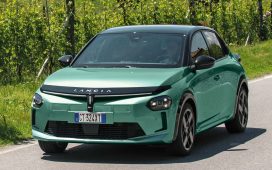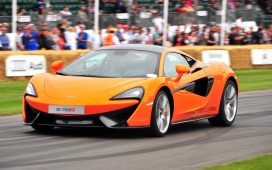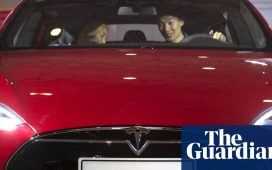Electric vehicles that stick to their brand’s signature design language offer a level of familiarity for potential buyers, while straying away from it can hamper overall adoption. Brands like Porsche, BMW, and MINI, for example, boast iconic design features that most motorists don’t want to see removed despite a shift under the hood from ICE to EV.
For those hesitant about new technology, familiar designs provide reassurance and reduce perceived risk in making the switch to electric. In truth, the vast majority of modern car buyers prioritize aesthetics and brand identity over anything else, and so by maintaining their design roots, automakers can make EVs seem like a natural evolution, easing the transition and potentially even accelerating their widespread adoption. Here are 10 electric vehicles that stood by their roots despite electrification.
In order to give you the most up-to-date and accurate information possible, the data used to compile this article was sourced from various manufacturer websites and other authoritative sources, including the EPA.

Model Overview
2024 Tesla Model S
The Model S has been around for a long time, but it is still one of the most competent EVs currently on sale. Here’s all you need to know about it.
1 Tesla Model S
The Tesla Model S was something of a trailblazer in the EV landscape, and it’s a damn good-looking car out on the road. Despite the manufacturer’s innovative role in aiding the electrification surge both on the U.S. soil and across the globe, the Model S looks more like a traditional luxury sedan rather than flaunting its futuristic capabilities. It boasts a sleek, aerodynamic profile with a low, wide stance and elegant lines, mirroring the look of some of its gas-powered counterparts.
Efficiency Specifications
|
MPGe (City) |
127 MPGe |
|
MPGe (Highway) |
116 MPGe |
|
MPGe (Combined) |
122 MPGe |
|
Energy Consumption |
28kWh/100 miles |
|
Range |
402 miles |
Step inside the Model S and you’re presented with a minimal but practical interior. The surprisingly spacious cabin hosts a plethora of premium materials and a user-friendly layout that avoids the overly futuristic designs found in some other electric vehicles. Instead, the Model S features a large central touchscreen and a digital instrument cluster, integrating high-tech features without overwhelming those drawn to making the switch from gas to electric.
Vehicle Highlights
- Impressive range and performance.
- Advanced technology and infotainment.
- Comprehensive safety features.
2 BMW i7
The BMW i7 is effectively the electrically-powered equivalent of the long-revered gasoline 7 Series. It doesn’t push a futuristic look, rather retaining the elegant lines and bold but sophisticated presence of its combustion engine sibling. This is a deliberate decision from the Bavarian automaker – and is also present in the designs of the i4 and i5. Why?
Well, in simple terms, the i7 harbors cutting-edge electric power and extensive digital features while still appealing to those who love the timeless appeal of BMW’s iconic offerings. At a glance, as one passes on the highway, it’s unmistakably BMW.
Efficiency Specifications
|
MPGe (City) |
87 MPGe |
|
MPGe (Highway) |
95 MPGe |
|
MPGe (Combined) |
90 MPGe |
|
Energy Consumption |
37kWh/100 miles |
|
Range |
321 miles |
In terms of the interior, the i7 offers the same plush, quiet cabin you’d expect from the 7-Series line. It’s luxurious and serene. Features inside include high-quality leather with power-adjustable reclining seats, massage functions, and a rear-seat entertainment suite.
Vehicle Highlights
- Powerful electric powertrains.
- Luxurious and high-tech interior.
- The executive lounge package is the one to go for.
3 Porsche Taycan
If you like Porsche, you’ll love the Taycan. This is a remarkable electric car that stays true to the brand’s beautiful and unique designs. While we don’t yet know the outcome of the decade-long longevity of EVs, this one might well be a future classic. Its sleek, low-slung, and sloping body and refined proportions are so unmistakably Porsche. The Taycan’s design also incorporates somewhat surprising practicality, particularly in the wagonized Cross Turismo and Sport Turismo trims.
Efficiency Specifications
|
MPGe (City) |
83 MPGe |
|
MPGe (Highway) |
82 MPGe |
|
MPGe (Combined) |
83 MPGe |
|
Energy Consumption |
41kWh/100 miles |
|
Range |
246 miles |
It’s also no surprise, then, that the Taycan offers astonishing performance with its rapid acceleration and nimble handling. Behind the wheel, drivers and passengers alike are presented with a conventional approach to its hallmark sophisticated interior. The dash layout, material quality, and overall ambiance of the cabin reflect Porsche’s legendary heritage, combining cutting-edge digital interfaces with a traditional, driver-centric environment.
Vehicle Highlights
- Awesome performance and acceleration.
- Innovative charging and battery technology.
- Luxurious and tech-heavy interior.

Model Overview
2024 Audi E-Tron GT: A Comprehensive Guide On Features, Specs, And Pricing
The sporty Audi e-tron GT takes luxury EVs to the next level of performance, and this is everything you need to know about it before buying one.
4 Audi e-tron GT
Here’s another one that falls in the potential ‘future classic’ category is the Audi e-tron GT. It’s a prime example of how electric vehicles can maintain traditional automotive design ethos while integrating new technology. The e-tron GT – which is arguably even sexier in its more powerful RS variant – features a lustrous, aerodynamic silhouette and distinctive Audi styling cues with the singleframe grille and sharp LED headlights, aligning closely with the almost all of the brand’s gas-powered models.
Like the Taycan and i7, the e-tron GT is immediately recognizable as an Audi, ensuring its popularity among those who prefer their electric cars to look, well, not electric! Its proportions and aggressive stance emphasize its sporty nature, drawing parallels with high-performance sedans and coupes rather than overtly displaying its electric underpinnings.
Efficiency Specifications
|
MPGe (City) |
85 MPGe |
|
MPGe (Highway) |
85 MPGe |
|
MPGe (Combined) |
85 MPGe |
|
Energy Consumption |
40kWh/100 miles |
|
Range |
249 miles |
The interior boasts high-quality materials, including both leather and Alcantara, along with a driver-focused layout that places a premium on comfort and usability. Multiple digital displays, including a head-up display, and a host of connectivity features ensure that the car is equipped with the latest tech, yet the overall feel is one of Audi’s familiar opulence rather than a space-age-type surrounding.
Vehicle Highlights
- Raw performance and power.
- Advanced charging capabilities.
- Variety of luxury options such as ambient lighting, heated and cooled seats with massage functions.
5 Mini Cooper Electric
Ah, the classic Mini Cooper – with an electric twist. What’s not to love? The exterior retains that iconic look that harks back to its original inception with compact dimensions, rounded headlights, and distinctive grille, making it instantly recognizable as a Mini. Let’s be honest, the brand could have done something polarizing with this electrified offering, but the overwhelming feeling is that if something isn’t broken, don’t fix it, and that’s exactly what Mini has done here.
Efficiency Specifications
|
MPGe (City) |
119 MPGe |
|
MPGe (Highway) |
100 MPGe |
|
MPGe (Combined) |
110 MPGe |
|
Energy Consumption |
31kWh/100 miles |
|
Range |
114 miles |
This theme continues inside the car, too. A 5.5-inch digital gauge cluster and 8.8-inch central touchscreen combine advancements in technology with the very same layout that screams Mini as soon as you climb inside. It’s contemporary, sure, but it’s also user-friendly – a line that is often detrimentally blurred in modern motoring.
Vehicle Highlights
- Retro charm with modern touches.
- Nimble handling and spirited performance.
- User-friendly interior.

Add TopSpeed to your Google News feed.
6 Mercedes-Benz EQS
A rival to the BMW i7, the Mercedes-Benz EQS is indeed slightly more futuristic looking than the S-Class it’s based on, yet its design language still leans more on tradition than avantgarde. Its proportions, with a lengthy wheelbase and sleek roofline, certainly echo the S-Class but with a more modern touch. It’s by no means a radical departure, though.
The exterior styling, while streamlined and uber-modern, disregards the overtly aerodynamic or edgy elements generally associated with EV’s hellbent on maximum efficiency. No, with the EQS, Mercedes-Benz has designed a vehicle here that aligns seamlessly with the brand’s heritage of understated elegance, focusing on luxury amenities and refinement as primary selling points rather than audacious visual statements.
Efficiency Specifications
|
MPGe (City) |
95 MPGe |
|
MPGe (Highway) |
98 MPGe |
|
MPGe (Combined) |
96 MPGe |
|
Energy Consumption |
35kWh/100 miles |
|
Range |
352 miles |
The interior follows suit… kind of. The highlight here is undoubtedly the MBUX Hyperscreen, a whopping 56-inch-wide display that spans the entire width of the dash. This screen integrates the instrument cluster, central touchscreen and passenger-side display into a seamless glass panel. It’s an infotainment marvel, and a digital cockpit experience unrivaled in its opulence and sophistication. Materials are as luxurious as you’d expect from the electrified version of the S-Class, from plush seating to meticulous craftsmanship throughout.
Vehicle Highlights
- The dashboard display is a sight to behold.
- Ventilated front seats, heated rear seats with matching pillows, and high-quality cabin materials.
- The EQS is available in multiple configurations, including rear-wheel drive and all-wheel drive variants.

Review
2024 Nissan Leaf: An Overlooked Electric Vehicle Perfect For First-Time EV Buyers
The Nissan Leaf has matured into a practical and reliable option for urban commuters seeking an environmentally friendly mode of transportation.
7 Nissan Leaf
Perhaps not the most exciting vehicle on this list, the Nissan Leaf still deserves its place. Despite its electric powertrain, the Leaf retains a conventional hatchback look that blends seamlessly into urban environments. Okay, it has that grille-less front end typical of countless electric vehicles, but Nissan has avoided those bold, attention-grabbing design elements seen in competitors from the likes of Hyundai and Tesla which often sport aggressive fascias and profiles that immediately shout “ELECTRIC!”.
Efficiency Specifications
|
MPGe (City) |
123 MPGe |
|
MPGe (Highway) |
99 MPGe |
|
MPGe (Combined) |
111 MPGe |
|
Energy Consumption |
30kWh/100 miles |
|
Range |
149 miles |
Much of the same goes on inside, as well. The Leaf has a practical and spacious cabin that prioritizes comfort and function over mesmerizing aesthetics. The interior design focuses on ergonomic simplicity, with straightforward controls and a clean dashboard layout. Materials are generally durable and functional, though not as premium-feeling to the touch as found in many more expensive alternatives. At just over $28,000, however, few will have complaints. This is an unassuming yet versatile choice for drivers looking for a daily commuter or for those needing an EV that will take them to the store and back without putting a foot wrong.
Vehicle Highlights
- The Nissan Leaf remains one of the most affordable electric vehicles on the market.
- The Leaf offers a surprisingly spacious interior with comfortable seating for both front and rear passengers.
- Nissan equips every Leaf with its Safety Shield 360 suite, which includes standard features like automated emergency braking with pedestrian detection and blind-spot monitoring with rear cross-traffic alert.
8 Fiat 500e
What Mini can do, so can Fiat, it appears. The 500e is quite simply the bog-standard Fiat 500 with an electric motor stuck under the hood – and that’s just how we like it. Compact dimensions and retro-modern styling cues like the rounded silhouette and distinctive front-end evoke a sense of nostalgic familiarity that appeals to fans of this classic hatch.
Fiat wasn’t for altering much here and that’s a testament to the Italian manufacturer rather than a criticism. This unwavering design decision is to keep the 500e as it caters more towards urban maneuverability and everyday driving over high-performance or long-distance trips. But that’s never what the original Fiat 500 was about.
Efficiency Specifications
|
MPGe (City) |
127 MPGe |
|
MPGe (Highway) |
104 MPGe |
|
MPGe (Combined) |
116 MPGe |
|
Energy Consumption |
29kWh/100 miles |
|
Range |
149 miles |
Updated modern amenities like a large 10.3-inch touchscreen and advanced driver-assistance features still reflect Fiat’s emphasis on style and compact efficiency rather than spaciousness. Simply put, the 500e is a solid option for anyone looking to get into a hatchback with adorable looks, affordability, and Italian heritage for city dwellings and the like, despite inherent trade-offs in range and interior space compared to some of the more utilitarian competitors in its price range.
Vehicle Highlights
- Retains the classic Fiat 500 city car aesthetics, updated for the modern era.
- It’s maneuverable and easy to park, making it ideal for navigating crowded city streets and tight parking spaces.
- Starting at $32,500, the Fiat 500e is competitively priced within the electric vehicle market.
9 BMW i4 M50
Another German offering is the BMW i4 M50. Despite being electrified, the i4 M50 maintains that same exciting design language we’ve come to expect from BMW’s gas-powered ‘M Power’ lineup, such as the sculpted hood and distinctive kidney grille, giving it a sporty and assertive appearance that aligns totally with BMW’s ‘M’ heritage. The M50’s profile, with its coupe-like profile and sloping roofline enhances its easy-on-the-eye nature, although this does sacrifice some practicality when compared with the standard i4.
Efficiency Specifications
|
MPGe (City) |
94 MPGe |
|
MPGe (Highway) |
98 MPGe |
|
MPGe (Combined) |
95 MPGe |
|
Energy Consumption |
35kWh/100 miles |
|
Range |
269 miles |
Inside, the BMW i4 M50 continues to bridge the gap between conventional and electric with a well-appointed cabin that prioritizes driver engagement and comfort. For BMW enthusiasts, the interior will feel extremely familiar with its leather upholstery, high-gloss trim elements, and customizable ambient lighting.
The centerpiece of the cabin is the expansive curved display housing BMW’s latest iDrive infotainment system, 14.9-inch touchscreen, and 12.3-inch digital instrument cluster. This setup provides intuitive access to navigation, media, and vehicle settings, complemented by advanced voice commands and standard connectivity options like Apple CarPlay and Android Auto.
Vehicle Highlights
- The BMW i4 M50 outpaces even the gasoline rear-wheel-drive M3 Competition.
- It comes standard with 19-inch wheels, with optional upgrades to 20-inch rims.
- Excellent tech and infotainment.

Model Overview
2024 Genesis Electrified G80: A Comprehensive Guide On Features, Specs, And Pricing
Can the Genesis Electrified G80 stack up against the best luxury electric cars on the market?
10 Genesis Electrified G80
The Genesis Electrified G80 is a seriously attractive car, which is no surprise as it is incredibly similar looking to its gas-powered sibling, the G80. From its smooth, flowing lines to its well-proportioned shell, it’s an understated and traditional appearance that could be easily mistaken for the standard G80 at first glance.
This design choice certainly won’t harm Genesis’ chances of converting many from the G80 to the Electrified G80. That said, the integration of the electric powertrain necessitated some compromises in practicality as the battery pack reduces trunk capacity and interior headroom ever so slightly.
Efficiency Specifications
|
MPGe (City) |
105 MPGe |
|
MPGe (Highway) |
89 MPGe |
|
MPGe (Combined) |
97 MPGe |
|
Energy Consumption |
35kWh/100 miles |
|
Range |
282 miles |
As with many of the vehicles on this list, these design cues are replicated inside. Luxurious materials abound, including soft leather upholstery and premium wood trim, it’s a refined and serene environment. High-tech features are aplenty, with the 14.5-inch infotainment system and high-end Lexicon audio system.
Vehicle Highlights
- The Electrified G80 features a robust dual-motor powertrain with a combined output of 365 horsepower and 516 pound-feet of torque.
- It supports rapid charging capabilities, allowing the battery to go from 10% to 80% in approximately 22 minutes when using a 350-kW DC fast charger.
- Additional comfort and convenience come from features such as three-zone automatic climate control, a digital gauge display, and a suite of driver-assistance technologies for enhanced safety.





















